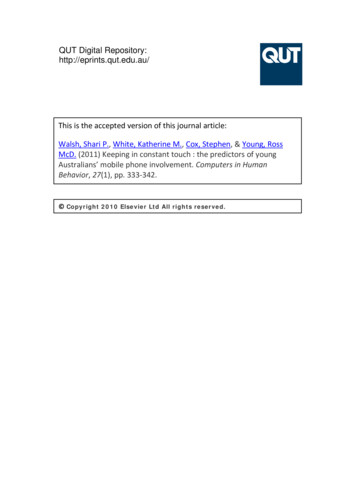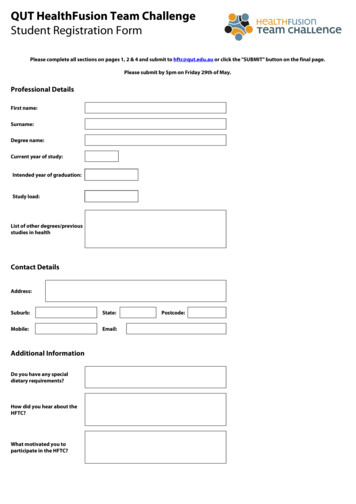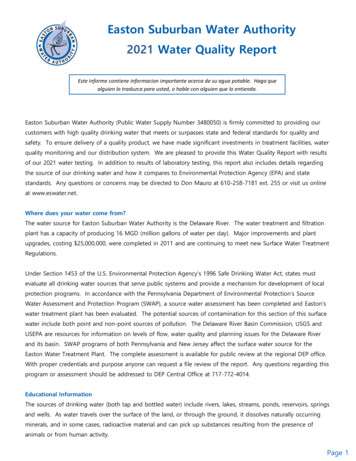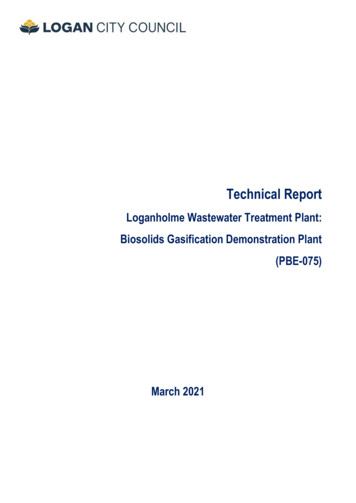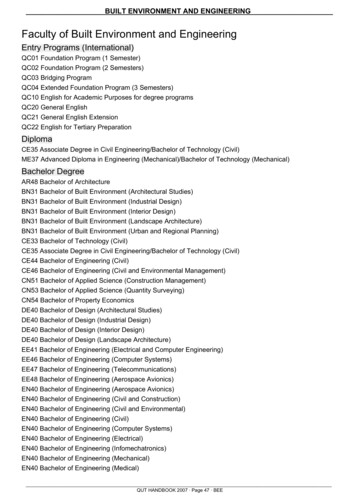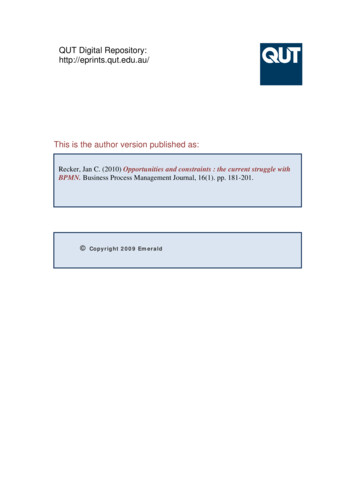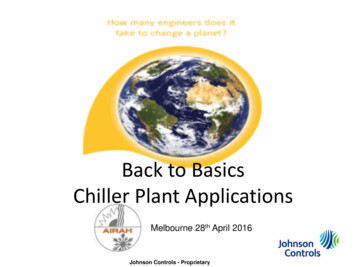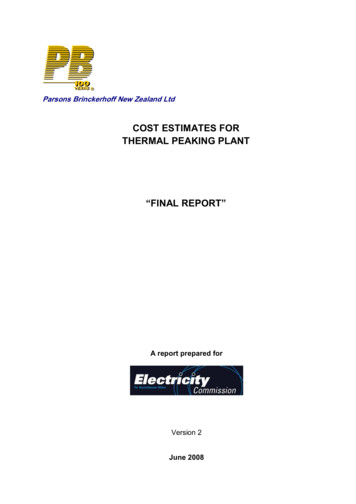
Transcription
Activity Kit 4Water Treatment Plant-WATER TREATMENT PLANT PREPARATION TIME: LESSON TIME:Appreciate the important aspectsof a WTP and complete anactivitythatshowssomeprocesses of a WTP.Understandtheroleoftechnology in a WTP and itsimpact on society and theenvironment.SAFETY NOTES:Supervision is recommended as theactivity uses:OBJECTIVES: Learn where our drinking watercomes from and how it gets toour household tap.What makes water unclean andwhat harmful contaminants it cancontain?Understandtheextremecomplexity of providing water tosociety.Discover the water cycle.Recognise the need to conserveand protect our environment andwater sources.Discover how water quality istested and the guidelines thatexist in controlling the quality ofwater. Australian Drinking WaterGuidelines (ADWG).ADWG 2002 (Australian DrinkingWater Guidelines) what it is andhow to test for it? Aluminium Sulfate SolutionUse only in ventilated areasDo not drink any samplesWORDS TO KNOW: Aluminium Sulfate, rSedimentary TankDisinfectionSludge ThickeningReservoirScourFlash MixingJar TestingTurbidityTo explore and identify thedifferent types of processes in aWater Treatment Plant (WTP).1
Activity Kit 4RAINWATER TO TAP WATERTHE PROCESSThe process from rainwater to tapwater is more complex than youmight imagine. The water that comesout of your tap has been throughvarious processes that clean andchangeitsoriginalproperties,physically and chemically.Do you know what the processesare? The aim of this Engineering Kitis to introduce you to a number ofWater Treatment Plant (WTP)processes that are commonly used ingetting clean potable water to yourhousehold.Civil Engineers design, monitor andmaintain water treatment plants andwater supplies. Civil engineers arevital in the treatment and delivery ofwater to your household.Water supply is the water that comesinto your property from the watermains via a service pipe and throughthe water meter into your home.Water is a limited resource. Lessthan one per cent of the earth's wateris fresh and can be utilised for humanconsumption. The amount of thiswater will never increase as the watercycle is a closed system.Australia is the driest inhabitedcontinent on earth. This seems hardto imagine when we have alwaysbeen able to turn on a tap and outcomes as much water as we need.Have you ever thought what wouldhappen if you turned on the tap andno water was available or the waterwas unfit to drink? What would youdo? How would you survive? Wherewould you get water from?Water Treatment PlantDRINKING WATERDrinking water is water that is safe forhumans to drink and to use fordomestic purposes, such as cooking,washing up, bathing and showering.The Australian Drinking WaterGuidelines (ADWG) provides theAustralian community and the watersupply industry with guidance onwhat constitutes good quality drinkingwater, it is concerned with the safetyof water from a health point of viewand with its aesthetic quality.According to the Australian DrinkingWater Guidelines:Ideally, drinking water should beclear, colourless, and well aerated,with no unpalatable taste or odour,and it should contain no suspendedmatter, harmful chemical substances,or pathogenic microorganisms.Drinking water must not containchemicals, organic substances ororganisms that may be harmful tohuman health. Drinking water shouldalso be at a reasonable temperatureand be free of unappealing odours,tastes and colour.The ADWG also define drinking wateras water‘ which, on the current state ofknowledge, is safe to drink over alifetime: that is, it constitutes nosignificant risk to health’.When most Australians turn on thetap, they expect a continuous supplyof drinking water that meets theseguidelines – water that is safe andpleasant to drink.Do you think that water from the tapis safe to drink? Do you observe yourtap water’s aesthetic quality – that is,its taste, colour and odour or do youjust drink it regardless?2
Activity Kit 4Water Treatment PlantPART ONE:PART TWO:MATERIALS:1. Divide the class into 4 groups andallocate them materials. 4 Students Booklets1 Master BookletActivity Worksheet Part OneBottles (Samples 1-3) of waterRAIN TO YOUR TAP .1. There are 3 bottles of water toassess; the object of this task is touse one of the physical propertiesof water, colour, to determinewhich one is suitable to drink.2. Using the sheet provided markselections.3. Identify the waters and reasonswhy you chose them?MATERIALS:Group1-4CoagulationFlocculation and Filtration andActivity Instruction BookletActivity Worksheet Part TwoPart A- Coagulation and Flocculation 4 500ml Plastic Beakers 4 Plastic stirring paddles 4 120ml Plastic Beaker 3 25ml plastic beakers 3 1ml Pipettes 2L Jug Timer- stop watch White Paper Alum Solution 10mg/L pH Strip Water 2L Soil 1gramPart B- Filtration 1 120ml Plastic Beaker Plastic Funnel Wet Sand Media Special Coal Small Gravel Stand & Holder for Funnel Tweezers Filter Paper Pump Laboratory Filter White Paper2. Each group will now start thecoagulationandflocculationprocess as outlined in theinstruction sheets.3. Part A involves a Jar Test andsedimentation of the suspendedsolids.4. Part B involves investigatingfiltration systems in the watertreatment process.3
Activity Kit 4Water Treatment PlantWATER TREATMENT PROCESSA Water Treatment Plant aims toensure that water is: Safe for human consumptionPleasant to consumersProvided at a reasonable costWater Treatment Plants have manyprocesses and steps before ahousehold turns on their tap andreceives water. From the dam to thetap there is a vigorous process withmany steps that are all essential inassuring high quality water fordrinking.This activity looks at two of theseprocesses; it will help you understandtheprocessesofcoagulation,flocculation and filtration which are allsteps in water treatment.COAGULATION AND FLOCCULATIONWhen particles are slow to settle (Aluminium Sulfate), are added to thewater.These react with theunwanted suspended particles toform larger particles, called floc. Thelarger size and weight of the flocsthen causes them to settle rapidly.Jar testing determines how muchalum to add to the water in atreatment plant to economically settleout the particles. Jar testing is widelyused in industry.FILTRATIONFiltration is also another importantelement of the treatment process.This process involves the waterpassing through a bed of fineparticles, usually sand. This processis called sand filtration.Othermaterials are also used in thefiltration process. Generally they arelayered.Originally filtration was a slowprocess, however because the sandfiltration processes become lesseffective at removing fine suspendedparticles at higher water flow rates.The water must be pretreated –coagulated and flocculated – beforepassing through the filter bed. Suchhigh rate direct filtration processesare widely applied to raw water withlow levels of suspended matter.The diagram below shows thecomplete water treatment plantprocesses. Note: where coagulation,flocculation and filtration occur in thedesign.Figure 1 WATER TREATMENT PROCESSThe Cooperative Research Centre for Water Quality and Treatment, 8 July 2004. http://www.waterquality.crc.org.au/aboutdw dwfacts.htm4
Activity Kit 4Water Treatment Plant.1. Fill the plastic jug with 2L of tap water.2. Add the 1gram of soil to 2L of tapwater.3. Using the large stirring paddle mix andstir it well into a homogenous solutionfor 1min. This represents the soilthat can be eroded and washed intodams from catchment areas beforethe water is treated.7. Place the corresponding 25ml plasticbeakers next to the corresponding500ml beaker. Repeat this for each ofthe quantities of alum.4. Using the 2L jug pour 500ml of thedirty solution into 4 separatecontainers, being careful you don’tspill the water. Make sure they’re asclose to 500ml as possible.5. Place the four containers in order,next to each other as shown below.8. Designate 1 person for each beaker tostir the mixtures and start each one atthe same time.9. Start the timer, from the moment youadd the Alum solution to all mixtures.Continue timing the entire activity.Control1ml2ml5ml6. Leaving one of the 500ml containersas a control in this experiment,measure 1ml, 2ml, and 5ml with themini plastic pipet from the Alumcontainer supplied.Place themeasured alum into the 25ml plasticbeakers provided.10. Add each alum solution (1ml, 2ml and5ml) to the corresponding 500mlcontainer and start to mix the solutionwith the paddles provided quickly for1min. This is flash mixing so youneed to do it fast and quickly (carefulnot to spill the dirty water). Make sureyou stir the control too.5
Activity Kit 4Water Treatment Plant17. What do you observe? Does morealum take less time or more time tosettle out?Is there an effect ofincreasing the alum? Is it economic toadd more chemical?18. After completing the jar test usingalum, think about the followingquestions.11.12. After 1min start to stir slowly(continue the timer) continue to stir thesolutionforanother5minintermediately.13. After a total of 6min stop stirring andremove the stirring wands. Let thesolutions settle. Continue timing theactivity.14. Complete the Part Two questions,remembering to check the timer toobtain your results.15. After10minusingthefourcorresponding 120ml plastic beakers,carefully pour the top layer of waterfrom the 500ml plastic beakers intothese, one by one, including thecontrol water.16. Place a sheet of white paper in front ofthe plastic 500ml beakers, line up the120ml beakers on the white paper.Compareandcontrasttheappearance of the 4 samples.Continue to answer the questions inPart Two. What step in the Water lation and Flocculation is the 1ststeps in the WTP process. This is wherecoagulant is added (in this case, alum)and the mixture is stirred rapidly and thenslowly. Then the particles settle out readyfor the sedimentation process. What do you think you will observe inthe water when you test yourprocess?The particles are settled out and thewater becomes clearer. How do you think this processcontributes to the overall watertreatment process?It allows water to be cleaned more quicklyas the larger particles are removed at thebeginning of the process. Did you even consider that treatedwater that comes out of your tapgoesthroughmanydifferentprocesses?The processes are vital to maintainingclean potable water to society.6
Activity Kit 4Water Treatment Plant1. Place the plastic funnel on thestand.2. Using the plastic funnel, follow thesteps to produce an individualfilter for each group.3. Place another marked 120mlbeaker under the funnel, ready tocollect the filtered water.4. Place cotton wool at the bottom ofthe funnel.5. Place the washed gravel into thefunnel above the cotton wool.6. Drain the water from the whitesand and place the wet whitesand above the gravel. Why doesthe sand have to be wet? Whatwould happen if it’s not wet?The sand needs to be wet so thewater solution can be absorbed moreeasily. If it was not wet there is apossibility that the water would catchdry sand particles and pull themthrough into the clean water.7. Start to add the special coal ontop of the sand layers (medialayer).8. You have made your filter.7
Activity Kit 4Water Treatment Plantfiltered 60ml. Make sure there isalways about 30mm from the topso that the water doesn’t overflow.13. Place the original 120ml beakernext to the filtered 120ml samplerespectively and compare theresults.14. Discuss and comment on theclean water that has beenproduced by the filter. (Do notdrink this water- it is not clean asthe process is only to help youunderstand the WTP process.)9. Make sure you don’t scour thetop of the filter when you arepouring the water in as it lessensthe effect of the filter.10. It is now time to test the filter youhave made. Flush clean tap waterthrough the filter to dislodge loosemedia. Use the given “filteredcontrol” container and then tip thewater out and continue theactivity.11. Pick up the settled water from thecoagulationandflocculationprocess and slowly start to pourthis water sample into the filterand allow it to soak through,notice the clean water runningthrough the tube into a newcontainer.15. Why can’t the WTP stop after thisstep of filtration? What followsFiltration? The water is cleanhowever it needs to progressthrough the rest of the processesto become safe to drink.After the filtration process thewater needs to be disinfected andin some case fluoridised. It thengoes into the distribution systemwhere it gets stored in reservoirsready for transport through pipesto your tap.16. Fill out the filtration activity sheet.17. Now its time to test the filter youhave just constructed, using thelaboratory filter provided.12. Continue to pour the waterthrough the filter until half is8
Activity Kit 418. Now unscrew the top of thelaboratory filter off.Water Treatment Plantthe pump draw the water throughthe filter into the container below.19. Using the tweezers, place a filterpaper on the top of the plasticcontainer.22. Then release the pump byreleasing the plastic nob on theside then take the pump off.23. Screw off the top of the filter andremove the filter paper with thetweezers.20. Place the round lid on top andthen screw the top section of thefilter on, this should secure thefilter paper.24. Place the filter onto another pieceof white paper.25. Repeat these stepsfiltered control water.withthe26. Note the difference between thefiltered and the unfiltered filterpaper. See below the samplesand what you should observe.21. Using the control water only, runthrough the unfiltered controlwater into the filter. Then using9
Activity Kit 4Water Treatment Plant How do you think this processcontributes to the overall watertreatment process?It is an important step that filters dirtywater into clean, drinkable water. It isone of the only processes some WTPuse and in that way a very importantprocess.Unfiltered Control Water SampleFiltered Control Water Sample27. After testing your filter, think aboutthe following questions. Did the media filter work?What step in the WaterTreatment Process is filtration?Filtration is the 5th process. It is oneof the last processes at the WTPbeforedisinfectionandthedistribution system. What do you think you willobserve in the water when youtest your process?After the filtration process you willhopefully see cleaner water.10
Activity Kit 4Water Treatment PlantDISCUSSIONPart A – Coagulation andFlocculation:1. Why do you think it isnecessary to treat water fordrinking?Treating water is an importantprocess in maintaining a healthysociety.The treatment of waterremoves germs and viruses from thewater that can cause disease andsickness in humans.1. What do you think wouldhappen if you put more alumsolution in the dirty water?There is a threshold for the amount ofalum what will affect differentsolutions that are what a jar test isactually for, to determine the amountof alum for each individual situationout on site, at the WTP.2. Canyouidentifywhichprocesses are the mostimportant in treating drinkingwater?All processes in the WTP areimportant however filtration is one ofthe most important processes as itcleans the water in an affective way.2. How does the flash mixingassist the jar testing?The flash mixing assists the jar testby allowing all the alum to beabsorbed into the mixture. The flashmixing will allow the flocculation to becompleted efficiently.3. Do you know where your watercomes from (which WTP)?Look on the Maps provided to see theclosest WTP to your home. Mt Crosby Water Treatment North Pine WaterIn Brisbane there are 3 treatmentplants. Mt. Crosby water suppliesBrisbane to area south of a line thatroughly runs from Enoggera across toNundah. We also supply Logan city,Ipswich City and when requiredLogan on- sell to Gold Coast City(last summer up to 50 ML/day). NorthPine supply north of the same lineand also to Redcliffe and supplementthe Pine Shire and Caboolture'swater. Please note that in winter,North Pine can be turned off for up tothree months for economic &/ormaintenance purposes and Mt.Crosby's two plants will supply allareas.Part B – Filtration:1. What do you think will happenif the water is dirtier (the riveris polluted in real life?)The jar testing will have a newthreshold and you may need morealum to produce the correctsedimentation.The filter will get dirtier quickly andthis can produce an inefficient filterthat does not clean the waterproperly. This is important in real lifedue to the fact that the filter needs tobe backwashed more than regular toclean the media.The media can get clogged up andproduce unclean water.2. If you had time you could addmore dirt to the water and trythe process again. What doyou observe? Write down yourobservations?If the water is dirtier the water will becleaned but not as capably as if itwas cleaner as the media gets11
Activity Kit 4Water Treatment Plantclogged with the sediment throughthe water.continues and the water is re cleanedin the WTP.3. Howhavetheseminormodifications changed the waythe treatment process isoperating?The minor change of dirtier waterchangestheflocculationandcoagulation and then also changesthe filters ability to produce cleanwater.A stronger dose of alum may beneeded and also the filter media mayneed to be altered to clean the watermore thoroughly. 4. In real life how do Engineersrectify this situation?Engineers in real life change theprocess by adding more alum orchanging the filter material to capturethe sediment as it passes through thefilter.In a laboratory, chemical engineerstest the samples of untreated water tofind the amount of alum that isrequired.Discussion challenge:Howdoesthedistributionpipeline network change in reallife and how does the demand ofcommunity change the quality ofa WTP?Dependingonthedistributionpipelines and whether it is a branchedsystem or a linear system, will have achange ion the level f disinfection thatthe WTP needs to provide, so thatthere si always residue in the system.Also the demand will affect the qualityof the WTP as if there is a higherdemand the water may not be asclean, over loading treatment plant orif there is not enough water can gostagnant in the tanks. What materials might Engineeruse to design real WTP,concrete, steel?The WTP are made on concretetanks that are deep into the ground,they have steel and concrete pipes.All WTP are different. Take a look atsome pictures of real WTP’s in theSouth East Queensland region. Discuss the advantages anddisadvantages of treating water,cost, health, and environment?The advantages of treating water areplentiful. The cost of treating waterfar out ways the cost of the healthissues that arises from unclean water.The health benefits from treatingwater can be seen in Australiacompared to 3rd world countries thathave increasingly more waterbornedeceases.The environment benefits for WTP’sdue to the fact that unclean water ispurifiedandcleaned.Theenvironmental aspect really playsapart with WWTP, as they clean thewater before it renters the rivers andstreams.So then the system12
Activity Kit 4Water Treatment PlantBACKGROUNDINFORMATION:When most Australians turn on a tap,clean, clear water runs out. But howdoes the local water supplier makesure the water is safe and pleasant todrink? The answer is likely to includesome form of water treatment.Most urban communities collect waterfrom a natural water body in thecatchment, whether a stream, river,or underground aquifer. The watercollected may then be stored in areservoir for some time.Unless it is already of very highquality, it then undergoes variouswater treatment processes thatremove any chemicals, organicsubstances or organisms that couldbe harmful to human health. Thewater is then delivered to thecommunity through a network ofmains and pipes called a distributionsystem.Why learn about water: Water issues affect everyone.Understanding how water issupplied and managed assists ina better appreciation of thisprecious resource.THEWATERCYCLE(HYDROLOGICAL CYCLE):The movement of water above, onand below the earth’s surface has nobeginning or end.Figure 2 WATER CYCLESecuring Our Water Future. A State Water Strategy for Western Australia.9 July 2004www.watercorporation.com.au/Docs/State Water Strategy complete.pdfSurface Water- used to describewater on the earth’s surface. Lakes and ReservoirsRivers and StreamsGroundwater- all water thatbeneath the earth’s surface.isWhen we turn on the tap, start thewashing machine or take a shower,we don’t necessarily think of the sunand the rain, but that is where thewater comes from.The processknown as the water cycle begins withenergy from the sun reaching water inoceans, seas, rivers and lakes.Water evaporates and becomeswater vapour. As the water vapourrises, it cools and condenses intobillions of droplets to form clouds.Vegetation is another source of watervapour. The roots of plants pumpwater out of the ground and pass itinto the atmosphere in a processknown as transpiration.Clouds hold rainwater as long as theystay warm. If the air cools, thedroplets merge until they are soheavy that they fall back to Earth asrain, hail or snow. The atmosphere iscapable of holding about 10 days’supply of rain – enough to drop about25 millimetres of freshwater over theentire surface of the planet.13
Activity Kit 4Water Treatment PlantRain and snow falling withincatchments can take several routes.Some evaporates, some seeps intothe ground to become groundwaterand some stays on or near thesurface to form streams, andultimately rivers.The water cycle is also referred to asthe hydrological cycle. Both termsdescribe the solar-powered systemthat provides freshwater to the landbased ecosystems upon which wedepend.The physical processes related to themovement and storage of waterwithin the environment are seen inthe diagram below:Figure 3 WATER CYCLENSW EPA, What is Water Quality? 12 July 2004. TORYOFWATERTREATMENT - WHY TREATWATER:The importance of good drinkingwater in maintaining human healthwas recognised early in history.However, it took centuries beforepeople understood that their sensesalone were not adequate judges ofwater quality.The earliest watertreatments were based on filteringand driven by the desire to removethe taste and appearance of particlesin water. Filtration was establishedas an effective means of removingparticles from water and widelyadopted in Europeeighteenth century.duringtheExactly why a clean and reliablewater supply was needed was notknown until the second half of thenineteenth century, when the natureof infectious disease was firstrecognised and the ability of watersupplies to transmit diseases such ascholera and typhoid was firstdemonstrated. After this, concernsabout the quality of drinking waterfocused on disease-causing microorganisms (pathogens) in publicwater supplies.14
Activity Kit 4Water Treatment PlantScientists discovered that visiblecloudiness, or turbidity, not only madethe water look unappealing; it couldalso indicate a health risk.Theturbidity was caused by particles inwater that could harbour pathogens.As a result, drinking water treatmentsystems were designed to reduceturbidity, thereby removing pathogensthat were causing typhoid, dysenteryand cholera. Storage of sludge, reuse anddisposalFiltrationDisinfection and FluoridationWater StorageWater DistributionBy the early twentieth century, betterprotection of water supplies fromsewage pollution and simple buteffective methods of water treatment(chlorination, sand filtration) hadgreatly reduced rates of waterbornedisease in developed nations.The water treatment processesdeveloped in the 19th century andrefined during the 20th century aresimple in nature. However, engineershave since developed ways ofmaking these processes happenfaster, in a smaller area and in amore controlled way at lower cost.As you will see in the coagulation andflocculation test (jar test), differentamounts of alum in the processchange the time the process takes toproduce a result.DIFFERENTTYPESOFPROCESSES: Collection of water from the damor reservoirCoagulantadded)(AlumandLimeFlocculation TankSedimentation Basin or TankSludge CollectionFigure 4 Water Treatment ProcessWhere does my drinking water come from and how is it treated?9 September 2004http://www.pueblo.gsa.gov/cic text/health/watertap/ch3.pdfCOLLECTIONOFWATERFROM DAMS:The water is collected from the damsand reservoirs via a pump to theWater Treatment Plant.The entire area from which a streamor river receives its water is called acatchment. A catchment is a naturaldrainage area, bounded by slopingground, hills or mountains, fromwhich water flows to a low point.Virtually everybody lives in acatchment, which may includehundreds of sub-catchments. Whathappens in each of the smallercatchments will affect the maincatchment.Sludge Thickening15
Activity Kit 4Water Treatment PlantThe water that comes out of a taponce flowed across a catchment andthat is why catchments are a crucialpart of urban water systems.Coagulation/flocculationprocessesgenerally use aluminium sulphate(alum) or ferric chloride as thecoagulant.The quality of the catchmentdetermines the quality of the waterharvested from it. Few communitieshave pristine water sources and thequality of water from most sources isat risk from activities occurring in thecatchment.The process is controlled so that thecoagulant chemicals are removedalong with the contaminants.Water resources can be classified assurfacewaterorgroundwaterresources. In both cases the qualityof the catchment determines thequality of the water harvested.Groundwater is a significant source ofsupply in many parts of ruralAustralia.It is also a significantongoing source for several majorurban centres. In parts of inlandAustralia, water from the GreatArtesian Basin is used for urban,agricultural and mining purposes.COAGULATIONANDFLOCCULATION:Coagulation and Flocculation is aprocess where by adding aluminiumsulfate to the raw water, settlementcan be achieved in a considerablyshorter time.In traditional water treatment, certainchemicals are added to raw water toremove impurities.While someparticles will spontaneously settle outfrom water on standing (a processcalled sedimentation), others will not.To cause particles that are slow tosettle or are non-settling to settle outmore readily, a soluble chemical ormixture of chemicals is added to thewater. Such a chemical is called acoagulant and the process is lation/sedimentationandfiltration is the most widely appliedwater treatment technology aroundthe world, used routinely for watertreatment since the early part of the20th century.SEDIMENTATION BASINS ANDTANKS:Some particles will spontaneouslysettle out from standing water (aprocess called sedimentation).Sedimentation is used to remove themajority of settleable solids fromcoagulated/flocculated raw water.The solids are removed before thewater passes to the filter hencereducing the solids load on the filterand increasing the efficiency of thetreatment plant.SLUDGECOLLECTIONTHICKENING:ANDSludge produced in water treatmentprocesses is both a waste productand a resource. Normally, the sludgeis contaminated by heavy metals andsometimesbyorganicmicropollutants. This makes it necessaryto treat the sludge before the valuableproducts can be recovered.The filter press is another processoption available for dewatering sludgefor final land disposal.16
Activity Kit 4Water Treatment Plantscientists call it a biofilm. Even verysmall particles stick to this biofilm andare held, while water of greatlyimproved quality passes out throughthe filter.Figure 5 BELT FILTER PRESSDintrade EKOSEP, Effective Belt Filter Press. 12 September 2004www.ekotuotanto.fi/The sludge which gathers at the baseof the mixing tanks is released into avalve and gravity fed through pipes tothickening tanks. At the thickeningtanks the sludge is further processedand polyelectrolyte is added to helpthe settling process.The sludge is dewatered on a beltpress and then squeezed into a drycake are produced. The conveyerbelt collects the dry cake and it istransported into a storage tank.FILTRATION:One of the oldest and simplestprocesses used to treat water is topass it through a bed of fine particles,usually sand. This process is calledsand filtration. In its simplest form,the water is simply passed throughthe filter with no other pre-treatment,such as the addition of a coagulant.Usually this type of filter will removefine suspended solids and also someother particles such as largermicroorganisms.Sand filtration is even more efficientwhen the water being treated passesthrough the sand filter very slowly.Over time the sand particles becomecovered with a thin surface layer ofmicroorganisms. Some might refer tothis layer as a slime but waterFigure 6 FILTERWhere does my drinking water come from and how is it treated?9 September 2004http://www.pueblo.gsa.gov/cic text/health/watertap/ch3.pdfFirst operating in London in the 19thcentury, slow sand filters are stillwidely used throughout the worldtoday. Although very effective, theyrequire a large area of land toachieve the sort of flows required bya large modern city.Additionalprocesses may also be needed toachieve adequate water quality.In the early 20th century, engineersdeveloped rapid sand filters, whichuse high rates of water flow andsophisticated backwashing of the17
Activity Kit 4filter bed tocontaminants.Water Treatment PlantremovetrappedThe sand filtration processes becomeless effective at removing finesuspended particles at higher waterflow rates, the water must bepretreated–coagulatedandflocculated – before passing throughthe filter bed. Such high rate directfiltration processes are widely appliedto raw water with
Activity Kit 4 Water Treatment Plant 4 WATER TREATMENT PROCESS A Water Treatment Plant aims to ensure that water is: Safe for human consumption Pleasant to consumers Provided at a reasonable cost Water Treatment Plants have many
